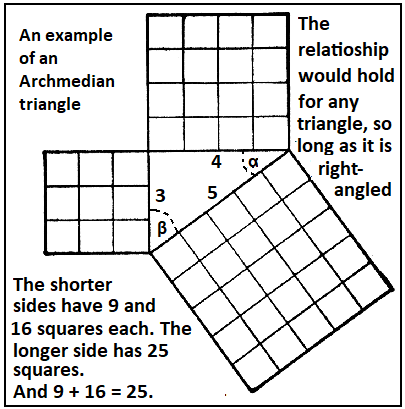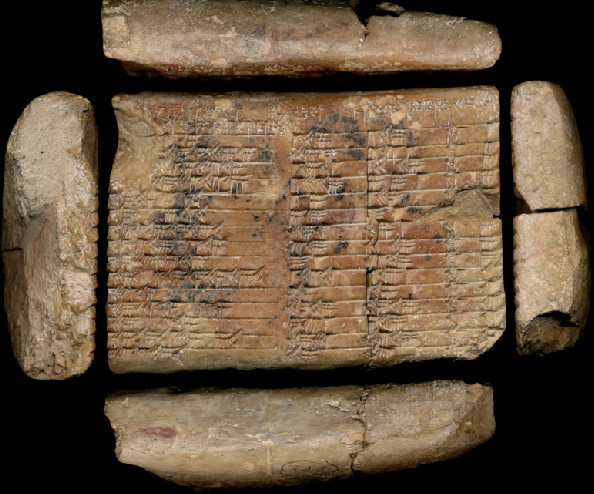Babylonians, long before Pythagoras and Euclid, had a firm grip on the mathematics of triangles, says S.Ananthanarayanan.
Much of mathematics derives from, or can be reduced to the properties of triangles. An ancient scrap of a clay tablet, unearthed early in the last century in Iraq, has been found to present the properties of triangles with unprecedented sophistication and accuracy. Interpretation of the markings on the tablet, which has only now been worked out, has been found to displace the Greeks of the sixth century BC as originators of the field of trigonometry, handing the position over to the Babylonians of a thousand years before.
Daniel F Mansfield and N J Wildberger of the University of South Wales, Sidney, in their paper in the journal, Historia Mathematica, demonstrate that the markings on the tablet represent real mathematical computation of great complexity, rather than an “unwitting creation of an effective trigonometric table”, as has been suggested.

The place of ancient Greek geometers as the forerunners of mathematics has been undisputed. While Euclid formalised the study of lines, circles, angles and areas, there is a special place for his predecessor, Archimedes, who made a seminal discovery about the right-angled triangle. This property, that squares drawn on the two shorter sides of a right-angled triangle are equal in area to the square drawn on the longest side, leads to the idea that the ratio of the sides of a right-angled triangle stays unchanged when the triangle grows or shrinks and depends only on the two lesser angles in the triangle.

The fact that this is the relationship among the sides of all triangles of the same shape leads to a way to measure the angles, marked as a and ß in the picture, based on the lengths of the sides. The ratio of the shorter sides to the longest, for different angles, a and ß, have been worked out and tabulated as the so-called trigonometric tables. These tables, which state the ratios for all possible angles, correct to less or more decimal places, are of great use to scientists and engineers. Given the length of one side of a right-angled triangle, we are able to work out the lengths of the other sides with the help of the other angles and a set of trigonometric tables.
The length of the sides of the triangle in the example shown are all whole numbers. Whole numbers, where the sum of the squares of two of the numbers is the square of the third number, like in a right-angled triangle, exists only for certain triads, or groups of three, of whole numbers. These sets of three numbers are known as Pythagorean triples. In such cases, the ratio of the lengths of the sides, and hence a measure of the angles in the triangle, can be worked out with great accuracy. In other cases, lengths need to be measured and the ratios are approximations. In principle, there is a triad of whole numbers that represents the ratio of the sides of any right-angled triangle, but discovering this triad, or the relevant Pythagorean triple, is not a trivial matter.

Other methods of working out these ratios, for pairs of lines that meet at an angle, were developed in later years. The Greek, Hipparchus, of the 2nd century BC developed a way using chords of a circle, Madhava of the Kerala School of Astronomy, in the 14th century developed a way using the sum of many terms of an infinite series of reducing fractions and this was followed by later Leibniz of Germany and others.
Plimpton 322
The Babylonian artefact, catalogued as Plimpton 322 as it was sourced by the publisher, George Arthur Plimpton, is a clay tablet with fifteen rows of sets of three numbers engraved in cuneiform. The notable feature of the engraving is that the three numbers in each set are related to Pythagorean triples. Specifically, the second and third numbers are the shortest and the longest sides of right-angled triangles, while the first number is related to the third side.
The origin of the tablet has been placed at Larsa, an ancient Sumerian city near the Persian Gulf and it antiquity, by comparison with other Old Babylon scripts, has been placed at between 1822 and 1762 BCE. The tablet itself is 12.8 cm by 8.8 cm in size and it contains the fifteen rows of writing, each with the sets of three numbers and then a serial number.

The numbers are written in the Babylonian sexagesimal number system, or numbers with a base of 60, in place of the base of 10 in our decimal system. There are thus separate symbols for the numbers from 1 to 59 (zero is denoted by a space) and the number 60 would be represented by the symbol for ‘one’, followed by a space, to form ‘10’, or one time the base (60) plus zero units. This system of counting, the paper explains, is richer and enables much higher exactness than the decimal system. The Old Babylon mathematics also looks at triangles from the point of view of the lengths of the three sides, without the notion of the angles, the paper says.
Modern trigonometric tables, which scientists and engineers use, are lists, for a range of angles, of the ratios of the sides of a right-angled triangle where the longest side is one unit long. The Plimpton 322 tablet, on the other hand, the paper says, is a series of sets of three whole numbers, where each set allows the ratios of the trigonometric table to be calculated, for a useful range of slope of triangles, with great accuracy. With this interpretation, the paper says, the Babylonian tablet becomes not only the oldest recorded trigonometric table, but also the most accurate one to date, as it is exact, with no approximation!
This function of the Plimpton tablet has been an unanswered question. Ever since the markings on Plimpton 322 were identified as Pythagorean triples, there has been extensive research into how the Babylonians may have worked out the numbers out and why they did it. The University of South Wales authors review some suggestions, like the tablet being a teacher’s aide or a representation of a class of right angled triangles and succeed in showing that these cannot be the case. On the other hand, they do show that the fifteen rows provide a mechanism to evaluate dimensions of triangles that correspond to angles from 45° to 59°, a range that would be relevant in normal construction work.
The paper reviews the tradition of Old Babylon mathematics, the geometry devised for civil work, and the Egyptian ratio-based measurements used to describe pyramids. And several other pieces of evidence, of ratios used to represent a slope, lead to a ‘ratio based framework for the study of triangles’ without the use of the angle as a metric, the paper says.
And there are examples, like finding the length of a side of the Great Pyramid of Gaza, given the height and the width of the base. The tablet of Babylon gives a better answer than the procedure that uses the table of Madhava!
------------------------------------------------------------------------------------------